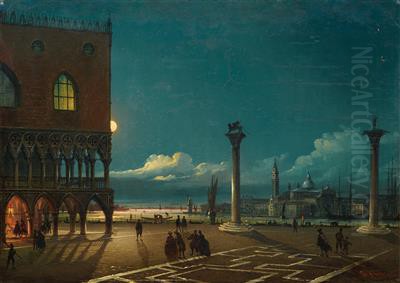
Giovanni Grubacs stands as a significant, if sometimes overlooked, figure in the lineage of Venetian view painters, or vedutisti. Active throughout much of the 19th century, he inherited a rich artistic tradition, masterfully adapting it to capture the enduring allure of Venice for a new generation. His work, characterized by meticulous detail, a keen observational eye, and a deep affection for his adopted city, provides a fascinating window into Venice as it transitioned from the twilight of its Republic to its role within a unified Italy and as an ever-popular destination for travelers and art lovers.
Early Life and Artistic Lineage
Giovanni Grubacs was born in 1829, reportedly in Germany, though his life and career would become inextricably linked with Venice. He passed away in 1919, his long life spanning a period of immense change in Europe and in the art world. The most crucial early influence on Giovanni was undoubtedly his father, Carlo Grubacs. Carlo, also a painter of Venetian scenes, established the family's artistic direction and reputation. While precise details of Carlo's birth vary in sources (often cited as circa 1802 or 1812, dying in the 1860s or 1870s), he was a recognized artist who specialized in the veduta tradition.
Carlo Grubacs himself was part of a generation of artists working in the wake of the towering figures of 18th-century Venetian painting. He would have been keenly aware of the legacy of masters such as Giovanni Antonio Canal, better known as Canaletto, and Francesco Guardi. Carlo's own work often displays a careful, detailed approach to depicting the famous landmarks and atmospheric canals of Venice, a style that he passed on to Giovanni. The Grubacs family, therefore, became custodians of a specific genre that had defined Venetian art for over a century. Giovanni's immersion in this environment from a young age would have provided him with an unparalleled artistic education, learning the techniques and thematic concerns directly from his father.
Artistic Education and the Venetian Academy
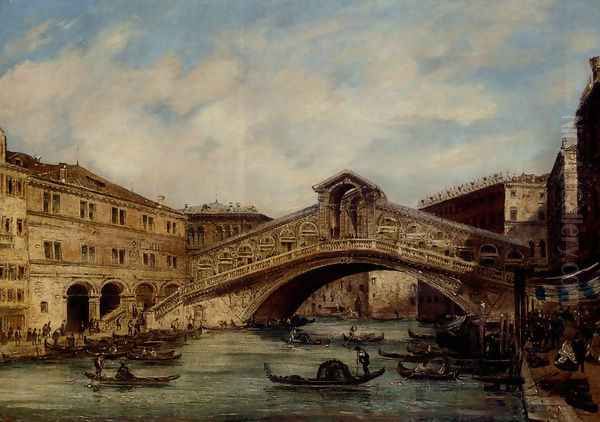
While the primary artistic training for Giovanni Grubacs likely came from his father, Carlo, within the family workshop, the broader institutional context of art education in Venice was the Accademia di Belle Arti di Venezia. The Accademia, a venerable institution, had been a center for artistic training for centuries, adapting its curriculum over time. It's noted that a "Grubacs" was a student at the Accademia, enrolling around 1818, a period when Leopoldo Cicognara was influential in shaping the institution. Given Giovanni's birth year of 1829, this 1818 enrollment almost certainly refers to his father, Carlo.
This places Carlo Grubacs within the Accademia's sphere during a formative period. The teachings there, even if rooted in classical principles, would have acknowledged the city's unique artistic heritage, including its strong tradition of view painting. Giovanni, therefore, grew up in an environment where the academic standards of the Accademia and the practical, market-oriented skills of the veduta workshop tradition were intertwined. He would have absorbed not only the technical skills of drawing, perspective, and color from his father but also an understanding of the artistic tastes and demands of the time.
The towering influences that permeated Venetian artistic circles, and which would have been studied and discussed both within the Accademia and in artists' studios, were undeniably Canaletto and Francesco Guardi. Canaletto, with his almost photographic precision, his mastery of light and shadow, and his ability to capture the grandeur of Venetian architecture, set a high bar. Guardi, while also a vedutista, offered a more atmospheric, impressionistic approach, with a looser brushstroke and a focus on the fleeting moods and daily life of the city. These two masters represented the poles of the veduta tradition, and artists like the Grubacs family often navigated a path between these stylistic approaches. Other significant 18th-century figures like Michele Marieschi and Bernardo Bellotto, Canaletto's talented nephew who achieved fame across Europe, also contributed to the rich tapestry of Venetian view painting that formed Giovanni's artistic inheritance.
The Enduring Tradition of the Venetian Veduta
The term veduta (Italian for "view") refers to a highly detailed, usually large-scale painting of a cityscape or other vista. This genre reached its zenith in 18th-century Venice, largely fueled by the Grand Tour. Wealthy young European aristocrats and intellectuals traveled to Italy as a rite of passage, and Venice was a key destination. These travelers were eager for sophisticated souvenirs, and vedute by artists like Canaletto, Guardi, and Marieschi became highly sought-after mementos of their time in La Serenissima.
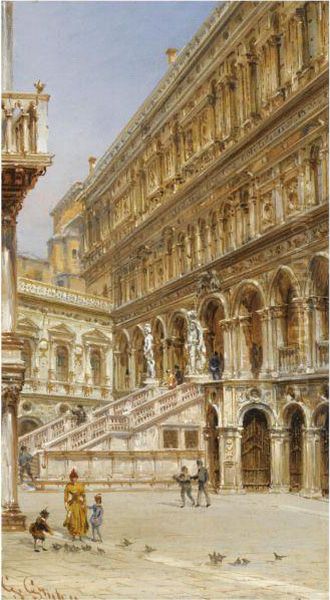
These paintings were more than mere topographical records; they were carefully composed works of art that celebrated the unique beauty, architectural splendor, and vibrant life of Venice. They often depicted famous landmarks such as St. Mark's Square, the Doge's Palace, the Rialto Bridge, and the Grand Canal, but also captured the city's festivals, regattas, and everyday scenes. The use of the camera obscura by some artists, including Canaletto, aided in achieving remarkable accuracy in perspective and detail.
By the 19th century, when Carlo and subsequently Giovanni Grubacs were active, the nature of tourism and art patronage had begun to change. The Grand Tour in its original form was waning, but Venice's allure remained potent. New generations of travelers, including a burgeoning middle class, continued to visit the city, and the demand for Venetian views persisted. Artists like the Grubacs family catered to this market, producing works that, while perhaps not always on the grand scale of their 18th-century predecessors, maintained a high level of craftsmanship and appealed to contemporary tastes. They continued the tradition of depicting Venice's iconic sites, often in smaller, more intimate formats suitable for the homes of a wider range of collectors.
Giovanni Grubacs: Artistic Style and Thematic Focus
Giovanni Grubacs developed a style that was deeply rooted in the traditions he inherited, yet possessed its own distinct characteristics. His paintings are consistently marked by their meticulous attention to detail. Every architectural element, from the intricate tracery of a Gothic window to the individual bricks or stones of a palazzo, is rendered with care and precision. This detailed approach extended to the depiction of figures – the gondoliers, merchants, and citizens populating his scenes – which, though often small in scale, are imbued with life and contribute to the overall vibrancy of the composition.
His palette was generally bright and clear, capturing the unique quality of Venetian light as it reflects off the water and illuminates the city's marble and stucco facades. He was adept at portraying different times of day and atmospheric conditions, from the crisp light of morning to the soft glow of twilight, and even nocturnal scenes, which were a popular subgenre. One of his noted skills was the faithful representation of Venice's famed waterways, capturing the reflections and movement of the canals that are so integral to the city's identity.
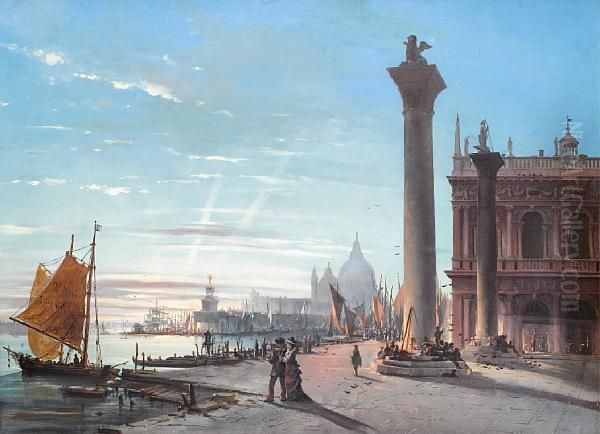
Thematically, Giovanni Grubacs focused on the classic Venetian subjects. The Grand Canal, with its procession of palazzi, was a recurring motif, as were St. Mark's Square (Piazza San Marco), the Doge's Palace (Palazzo Ducale), and the Rialto Bridge (Ponte di Rialto). He painted these landmarks from various perspectives, often including lively human activity that underscored Venice's role as a bustling, living city. Beyond the grand vistas, he also depicted quieter, more intimate corners of Venice, showcasing the charm of its smaller canals and picturesque campi (squares). His works often convey a sense of the city's historical atmosphere, capturing not just its physical appearance but also its enduring spirit. While adhering to a naturalistic style, his compositions are carefully balanced, demonstrating a strong understanding of perspective and spatial relationships.
Representative Works and Notable Compositions
While a comprehensive catalogue raisonné of Giovanni Grubacs's work is a scholarly endeavor, several paintings are frequently cited or appear in collections and auctions, giving insight into his oeuvre. One of his most evocative and well-known types of scenes is the nocturnal view. A prime example often mentioned is "Piazza San Marco by Moonlight, Venice." In such works, Grubacs masterfully contrasts the deep blues and indigos of the night sky with the warm, artificial light emanating from windows or lanterns, and the ethereal glow of the moon on the architecture and water. These paintings capture a romantic and mysterious side of Venice, appealing to the 19th-century sensibility.
Other typical subjects that appear under his name include various views of the Rialto Bridge, a perennial favorite for vedutisti. These paintings would showcase the bridge's iconic arch, the bustling activity of shops upon it, and the gondolas and boats passing beneath. Similarly, views of the Doge's Palace and the Piazzetta San Marco, often looking out towards the island of San Giorgio Maggiore, were staples. These compositions allowed him to display his skill in rendering complex architectural details and expansive perspectives.
Paintings titled "The Grand Canal, Venice," with various specific viewpoints (e.g., looking towards Santa Maria della Salute), are numerous. These works capture the grandeur of Venice's main waterway, lined with magnificent palaces. He also depicted specific events or atmospheric conditions, such as "The Bacino di San Marco on Ascension Day," continuing a tradition of capturing Venetian festivals. Works like "Ponte Dei Sospiri, Venice" (The Bridge of Sighs) highlight another famous and romantically charged landmark. The consistency in his detailed execution and his ability to capture the quintessential Venetian atmosphere are hallmarks across these varied subjects. His output was prolific, catering to a steady demand, and many of his works are found in private collections, attesting to their popularity among visitors to Venice.
The Grubacs Workshop and Enduring Legacy
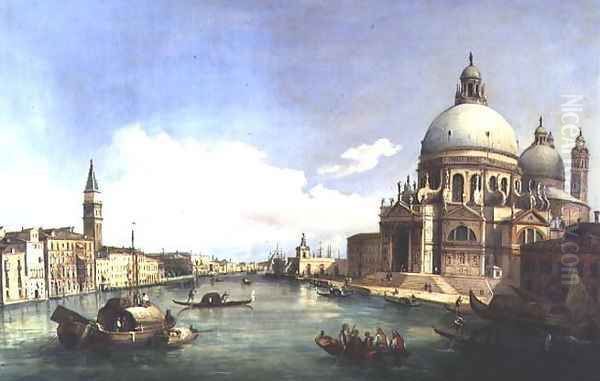
It is highly probable that Giovanni Grubacs operated, or at least was central to, a family workshop, a common practice for artists, especially those in a specialized and marketable genre like veduta painting. This system allowed for efficient production and the training of assistants or family members in the established style. His father, Carlo, had already laid the groundwork for this, and Giovanni would have continued and expanded upon it. The consistency in style and quality across many works attributed to "Grubacs" (sometimes without a clear distinction between Carlo and Giovanni in older attributions) suggests a well-organized studio practice.
The legacy of Giovanni Grubacs lies in his role as a skilled and diligent continuer of the Venetian veduta tradition well into the 19th century and even into the early 20th century. At a time when artistic styles were rapidly evolving across Europe – with Romanticism, Realism, and eventually Impressionism and Post-Impressionism taking hold – Grubacs remained largely faithful to the meticulous, naturalistic depiction of his adopted city. This was not necessarily a sign of being out of step with his time, but rather a testament to the enduring appeal of Venice and the specific genre he mastered.
His paintings provided a visual record of Venice during a period of significant transition. While the grand political power of the Venetian Republic was a memory, the city's cultural and aesthetic importance only grew. Grubacs's works captured this Venice – a city of timeless beauty, but also one that was adapting to new realities. His detailed depictions of buildings, boats, and figures offer valuable insights into the material culture and daily life of 19th-century Venice. Today, his paintings are appreciated for their technical skill, their charming portrayal of Venice, and their place within the long and distinguished history of Venetian view painting. They continue to be sought after by collectors and are represented in various public and private collections.
Contemporaries and the 19th-Century Venetian Art Scene
Giovanni Grubacs worked during a vibrant period in Venetian art, though one often overshadowed by the brilliance of the 18th century or the revolutionary movements happening elsewhere in Europe. Nevertheless, Venice in the 19th century had a lively artistic community. Among his contemporaries in the realm of Venetian view painting was Ippolito Caffi (1809-1866). Caffi was known for his often dramatic and innovative perspectives, including striking nocturnal scenes and aerial views, sometimes with a more Romantic sensibility than Grubacs. His work, like Grubacs's, catered to the tourist market but often pushed the boundaries of traditional vedute.
Other Venetian painters of the era explored different genres. Giacomo Favretto (1849-1887) became highly popular for his charming and lively genre scenes depicting everyday Venetian life with a fresh, anecdotal quality and vibrant color. While different in focus from Grubacs's architectural vedute, Favretto's work also captured the spirit of the city and its people.
The landscape tradition was carried on by artists like Guglielmo Ciardi (1842-1917), who, along with his artist children Beppe Ciardi and Emma Ciardi, painted Venetian lagoons and mainland landscapes with a sensitivity to light and atmosphere that sometimes approached Impressionism. Though their focus was often more on natural landscapes than urban cityscapes, their work shared Grubacs's deep connection to the Venetian environment.
Other artists who engaged with Venetian subjects included Luigi Querena (1824-1887), who also painted vedute and historical scenes. The influence of the Accademia continued, with figures like Pompeo Marino Molmenti (1819-1894) active as both a painter and an influential teacher. Later in the century, artists like Ettore Tito (1859-1941) and Milesi Alessandro (1856-1945) gained prominence with genre scenes, portraits, and depictions of Venetian life that reflected newer artistic trends, moving away from the precise veduta style but still deeply Venetian in spirit.
Further afield, but indicative of the broader Italian art scene, were movements like the Macchiaioli in Florence, who were developing a style of painting based on "macchie" (patches or spots) of light and shadow, akin to an early form of Impressionism. While Grubacs's style remained distinct from these more avant-garde movements, he was part of a rich artistic ecosystem. Even artists like Federico Zandomeneghi (1841-1917), Venetian by birth, eventually moved to Paris and became associated with the Impressionists, showing how Venetian artists were also engaging with international trends. The context of these varied artistic practices highlights Grubacs's dedication to a specific, enduring tradition within a changing art world. His contemporaries included other view painters like Antonio Rotta, known for genre scenes, and Luigi Nono, who also depicted Venetian life with a more academic-realist approach. The German painter Oswald Achenbach, though not Venetian, was renowned for his Italian landscapes, including views of Venice, showing the international appeal of the subject.
Exhibitions, Collections, and Market Reception
Giovanni Grubacs's works, both during his lifetime and posthumously, have enjoyed consistent appreciation, evidenced by their inclusion in exhibitions and their performance in the art market. While comprehensive exhibition records from his active period might be dispersed, contemporary mentions and the continued presence of his works in gallery inventories and auction catalogues attest to his recognized status.
More recently, his paintings continue to feature in specialized exhibitions and sales. For instance, works by Giovanni Grubacs were noted as being part of an exhibition at the Pandolfini Arcade in Florence in 2024. His paintings also appear regularly at art auctions across Europe and North America. For example, a piece might be featured in a "Kunst auction," as noted for 2023, indicating his works are part of the broader European art market.
His paintings are held in both private and public collections. The Galleria dell'Accademia in Venice, the city's premier museum, reportedly holds works by him, which is a significant indicator of his artistic standing within Venice itself. Many more are in private hands, often passed down through families who acquired them in the 19th or early 20th centuries.
In terms of market performance, Giovanni Grubacs's paintings command respectable prices, reflecting their quality and the enduring popularity of Venetian scenes. Auction estimates and sale prices can range from several thousand euros to tens of thousands, depending on the size, subject matter, condition, and provenance of the work. For example, a painting like "Venice, the Rialto Bridge" might be estimated in the range of €30,000 to €35,000 at a major auction house. A nocturnal scene, such as "Venice, St. Mark's Square by Night," could achieve similar figures, for instance, selling in a range of €25,000 to €35,000. These figures demonstrate a solid and sustained interest from collectors who value his skillful execution and the timeless appeal of his Venetian vistas. His contribution to the naturalistic Venetian style and his precise capturing of 19th-century social details and fashions are often highlighted by art dealers and auction houses.
Conclusion: A Steadfast Chronicler of Venetian Charm
Giovanni Grubacs carved a distinct niche for himself within the long and storied tradition of Venetian view painting. Born into an artistic family and honing his skills under the tutelage of his father, Carlo, he dedicated his long career to capturing the multifaceted beauty of Venice. His works, characterized by meticulous detail, luminous clarity, and a faithful depiction of the city's iconic architecture and lively atmosphere, served as cherished mementos for 19th-century visitors and continue to enchant viewers today.
While the art world around him saw dramatic shifts towards modernism, Grubacs remained a steadfast practitioner of the veduta, demonstrating that this genre still held immense power and appeal. He was not an isolated figure but part of a continuum of artists, from the legendary Canaletto and Guardi to his own contemporaries like Caffi and Favretto, each contributing to the visual narrative of Venice. His paintings of St. Mark's Square under moonlight, the bustling Rialto, or the majestic sweep of the Grand Canal are more than just topographical records; they are affectionate portraits of a city that has captivated the imagination for centuries. Giovanni Grubacs's legacy is that of a skilled craftsman and a sensitive observer, whose art provides an enduring window onto the timeless charm and enduring spirit of La Serenissima.